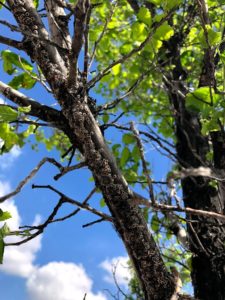Every year we are asked why elm trees turn black in Edmonton. The answer is they don’t. The issue is a little insect that is creating a big problem. European elm scale is a small sucking insect that targets large leaf elm trees. They infest elm trees and excrete copious amounts of honeydew. That honeydew, in turn, grows a sooty mold, covering everything in a charcoal-like sticky substance. In this post we will go over the insects, their hosts, and what we can do about them.
The Problem
European elm scale or Gossyparia Spuria is a scale insect that targets elm trees. The adult scale is a flat brown bug that has waxy white edges on its back. The young are tiny bugs that range from yellow to brown.
Scale is a sap sucking insect with piercing mouth parts for sucking the sap from the thinner areas of bark. As it feeds on the sap, it excretes honeydew, which covers the tree and everything underneath the tree. That honeydew will then become covered with a sooty black fungus.
The female scale spends the winter in its second instar covered in a waxy gray covering. An instar is a molting stage or pupal development that some insects go through. Male scale spends the winters in white cocoons, which are usually found in branch crotches. In the spring, the scale emerge from their cocoons and coverings and begin feeding. Female scale can reproduce both sexually and asexually. The female carries the eggs on her underside until they hatch. The young scale are called crawlers and look like small yellow or orange spots. After hatching, the crawlers will make their way to the underside of leaves to feed until they are large enough to feed on the branches and stems. Adult scale attach themselves to branches and stems to feed, usually where the bark is thin but still on wood with good vascular flow. Lower canopy and branch crotches are common areas for the scale to cluster.

The Victim
European elm scale target elm trees exclusively, with a heavier focus on American elms although they will still target Siberian, Chinese, and most variants. Elm trees in Alberta can be identified by their characteristic growth pattern of one straight trunk leading into many branches that grow up and out, creating a vase shape. Elm tree leaves are dark green on the top side and paler green underneath, with an oblong shape with each side serrated. One side of the leaf will be slightly longer than the other and the leave will have distinct veins leading from the leaf center straight to the edge. Elm bark is brownish gray with more mature bark being more gray than brown. It is common for elms in Edmonton to have black bark due to sooty mold.

The Symptoms
Healthy elm trees can handle a scale infestation, but a heavy infestation can send even the strongest and most mature elms into decline over time. Heavy infestation can cause branch dieback led first with chlorotic and stunted foliage. Chlorotic foliage is a yellowing of leaves due to a lack of chlorophyll. Younger trees have a much harder time fighting off elm scale as they have more young bark and less energy to resist damages.
The honeydew is typically the biggest problem caused by scale insects. Even if your tree is handling the infestation well the insects will still cover everything with their sticky excrement, which can be a difficult to get off vehicles and outdoor furniture, even before it develops sooty mold growth.

What Can Be Done
- Keep your trees healthy. Healthy elm trees will be able to thrive despite scale infestation and will be less likely to develop life threatening infestations. Pruning for tree health during elm pruning season will help the tree stay strong and reduce risk of the tree having to fight off multiple ailments. Ensure the tree is watered and fertilized as necessary and that the tree base has mulch for better moisture retention. Have other ailments treated as they occur in order to reduce stress on the tree. Even a mature elm tree will struggle under multiple infestation. Other common infestation for elm trees are thrips, aphids, caterpillars, and galls.
- Keep your yard predator friendly. Many predators such as parasitic wasps, birds, ground beetles, lady beetles, and green lacewings will target and keep scale populations under control.
- Infestations can be treated with insecticide. Contact a qualified arborist to have infestations assessed and treated.
What Kentucky Blue Grass Can Do
We can maintain the health of your trees through professional assessment, pruning, fertilizing, and watering. We can also provide fast acting and effective insecticide treatments for scale by injecting organic insecticide directly into the tree.
Professional Reference
Denise Allen, ISA Certified Master Arborist, February 24th, 2021.
References
https://www.lethbridge.ca/Things-To-Do/Parks/Pages/EuropeanElmScale.aspx
https://www.fs.usda.gov/Internet/FSE_DOCUMENTS/stelprdb5350728.pdf
http://cues.cfans.umn.edu/old/Web/126EuropeanElmScale.pdf
https://www.mortonarb.org/trees-plants/tree-and-plant-advice/help-pests/scale-insects


Comments are closed